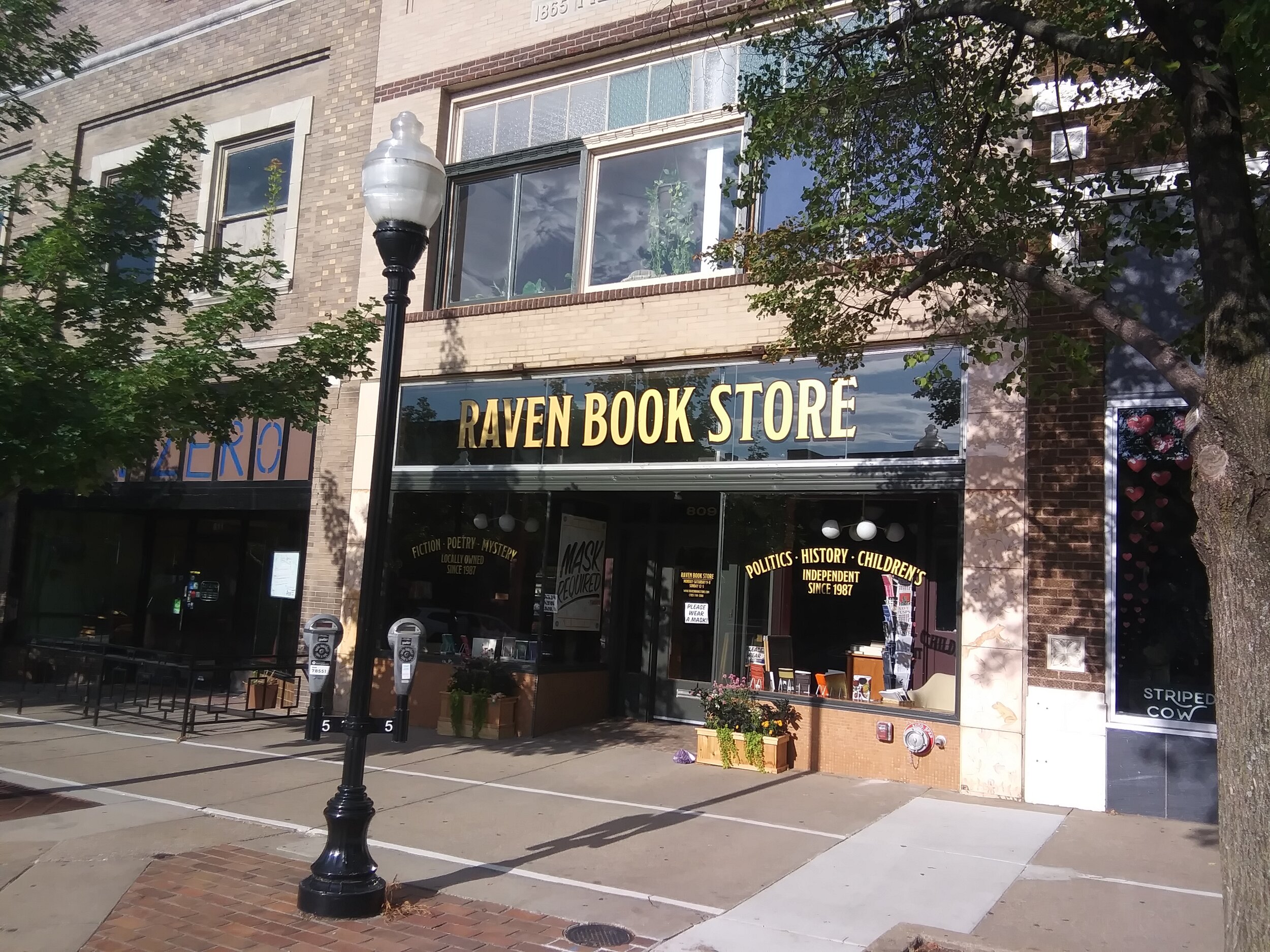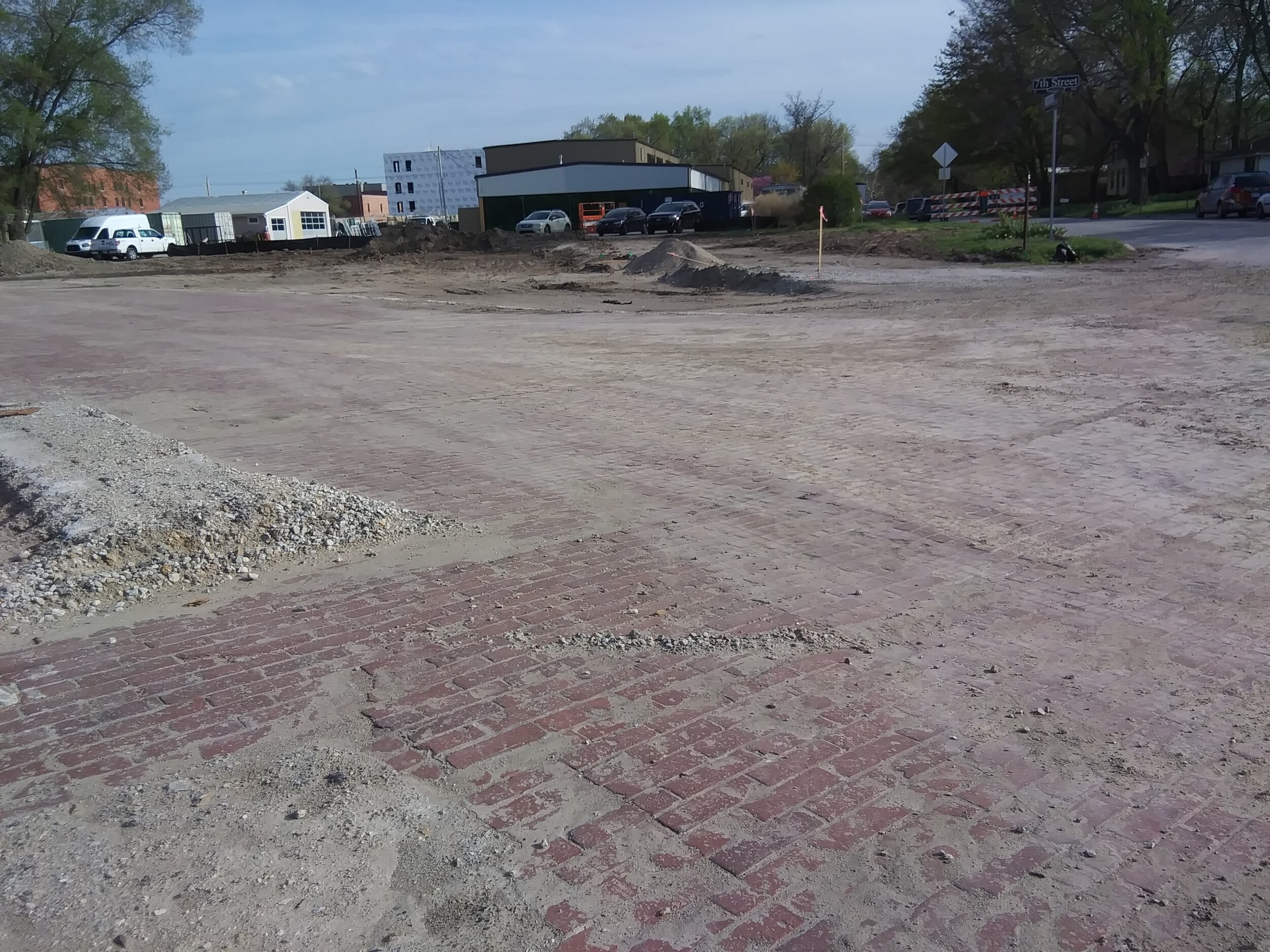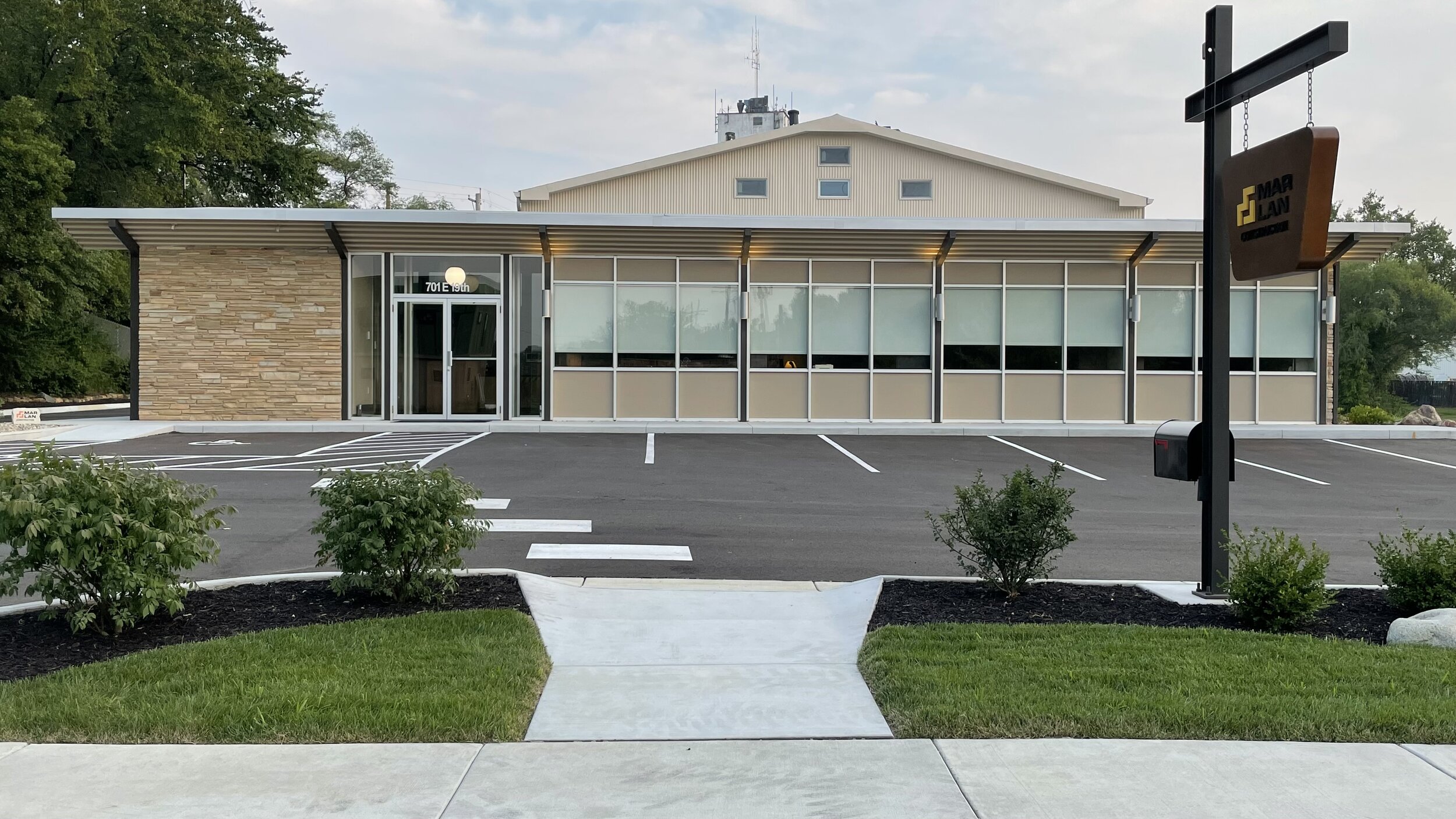LPA Announces September Preservation In Progress Awards
/For our September Preservation In Progress Awards, LPA is excited about a downtown rehab that allows a Lawrence favorite to move to Massachusetts Street, a city-owned parking lot resurfacing project that took a historic turn, and a mid-century modern commercial rehab that brings back memories of an iconic business and its owner.
The Raven Book Store, 809 Massachusetts Street
It would be hard to imagine two businesses more different than an ax-throwing entertainment venue and a bookstore. But the transition from one to the other — through a crucible of fire — has brought new life to the Newmark Building at 809 Massachusetts Street.
Built in 1865, the building reopened recently as the new location for longtime Lawrence bookseller The Raven. The previous tenant of 809 Massachusetts was Blade & Timber, an ax-throwing attraction that was forced to close in October 2018 after an electrical fire broke out in the building. While the fire caused extensive damage, according to a report in the Lawrence Journal-World, Dalton Paley of Paley Properties & Investments, the building’s owner, was committed to ensuring that the structure maintained its historic character.
“I’ve been fixing up historic buildings since I started working with my dad, and he did it before me,” Paley said. “Every building we own right now is on the historic registry. This type of rehabilitation project preserves the character of downtown, and to me, downtown Lawrence is the heart of our city.”
Working with Hernly Associates Inc., Paley Properties & Investments was able to restore the limestone façade on the back of the building, including two original windows; maintain most of the original wood floors on both the first and second floors of the building; and reinstall the first floor’s original tin ceilings. Paley also rehabilitated the Massachusetts Street storefront, restoring the transom above the front doors to let more light into the space. In addition to space for the relocated Raven Book Store space on the first floor, the building now has two new one-bedroom apartments upstairs.
“We were really excited to honor both the history of The Raven and the history of this space,” said Danny Caine, owner of The Raven. “The whole concept is to merge a traditional historic storefront bookstore with a bold and exciting kids section in the back.”
“Much of the end product is thanks to Danny’s vision,” Paley said. “We like to take on projects with a specific tenant in mind, and The Raven was a perfect match, combining our interest in preservation with a lot of smart thinking about what will attract retail shoppers to Lawrence.”
Amtrak/Santa Fe Depot Parking Lot
Sometimes a truly amazing discovery can sprout from mundane beginnings. Back in March, a contractor hired by the city began work on a routine parking improvement project just east of the historic midcentury-modern Amtrak/Santa Fe Depot at 413 E. 7th Street. Farmer’s Excavating was scraping away layers of dirt and gravel that had been there for years when they uncovered something that was certainly curious: an intact layer of red brick underlying almost the entire surface. Rather than continuing with the excavation and adding the brick to the debris pile, the contractor stopped work and alerted city engineer David Cronin.
Was it an abandoned brick street? The bricks were mortared together, which would not have occurred in typical brick street construction. Diving into research on the newly discovered brick, Cronin contacted Historic Resources Administrator Lynne Braddock Zollner; Stan Hernly, the project architect for the depot rehabilitation project that had been completed in 2019; members of the volunteer group Depot Redux, which had worked for years to save the modern station; and nearby East Lawrence neighbors, some of whom had lived in the area for many years.
The answer provided a link to the property’s historic past. The brick surface — nearly the length of a football field — was the floor and loading platform of the old freight depot that stood next to the original two-story depot until that structure was demolished after the great flood of 1951. Today’s modern version of the depot was built in 1956, and it is believed that the freight building survived into the 1960s.
Once the historic material had been identified, the city’s attention focused on whether it could be incorporated into the plan for the new lot. It was determined that the brick surface had a good base and an acceptable slope for drainage. Keeping the brick as usable surface on the lot’s north side could accommodate 17 parking spaces next to the east end of the depot, and the brickwork could be incorporated as a key element of the larger parking lot project.
As he worked through the preservation of the brick, Cronin moderated an email chat with more than a dozen community stakeholders to discuss various aspects of the project. Several details were thoughtfully worked out by this ad hoc group. One of particular interest was the appearance of a 10-foot-wide slash that ran diagonally through the brick field. It was determined that there had been a rail spur there to a warehouse just south of the site, but the rails had been removed at some point. The group analyzed three different options to preserve this facet of the site’s history before deciding on a concrete outline inlaid with brick, running counter to the direction of the brick in the rest of the lot.
Work has begun again, and what would have been a typical parking lot will now help current and future generations understand East Lawrence’s rich railroad history through a long-hidden physical connection to its past. City staff and the contractor followed a preservation best practice when a surprising and possibly significant historical element was uncovered: Work was stopped, experts and neighbors were engaged to discuss and resolve the issues presented, and plans were modified to allow the historic material to exist within the new project. LPA cannot applaud this preservation effort loudly enough.
Mar Lan/Zimmerman Steel Building, 701 E. !9th Street
COURTESY OF HERNLY ASSOCIATES.
The old Zimmerman Steel Building, a much-loved local midcentury-modern commercial structure that sits just east of the Burroughs Creek Trail at 701 E. 19th Street, is looking mighty fine these days. And there’s a good reason why: its new owner/occupant is cut from the same fabric as Lee Zimmerman himself, who acted as his own general contractor to build the structure circa 1960 to house his company. Now this iconic structure is owned by Mar Lan Construction, a commercial general contracting, design-build and construction management firm, and just as Zimmerman built it, Mar Lan has now rehabilitated it.
In 53 years of business at the 19th Street location, Zimmerman Steel fabricated and sold structural steel and architectural metal components for many prominent buildings in Lawrence, on the KU campus, and throughout northeast Kansas. Many of the midcentury-modern buildings in Lawrence were built with metal pieces purchased at Zimmerman Steel.
The Zimmerman Steel Building was built in two phases in the mid-20th century as Lee Zimmerman moved his operation from 1832 Massachusetts. The shop space came first, in 1959, and Zimmerman designed and fabricated the steel frame himself. In 1963, Zimmerman added office space to the north that was designed in the midcentury-modern style by the architectural firm Robertson & Ericson. Zimmerman enjoyed this modern style, as he had built his family home at 200 Nebraska — now listed with LPA help on the Lawrence Register of Historic Places — in the same style in 1955.
Founded in Lawrence in 1999 by Gale Lantis, Brian Lantis and Kevin Markley (James Allen was added later as a fourth partner), each principal in Mar Lan has a life in construction that goes back more than 30 years. When the company began looking for centralized space, it had an office at 1008 New Hampshire and storage and shop spaces in two other locations.
“We wanted something unique and different,” Markley says, “and we had always admired the Zimmerman Building back to the days when we were customers of Zimmerman Steel.” But when they inquired about a possible sale or lease from what was then the property’s third owner, they were told no.About two years later though, that owner reached out to see if they still had interest in a purchase, and Mar Lan leapt at the opportunity.
Evaluating the site, they could see that a lot of updating was necessary, but Markley remembers it was important to “keep the original concept and layout sacred…the spaces seemed like they were made for our programming.” They contracted with Hernly Associates to write a nomination to the Kansas Register of Historic Places and were approved for listing in February. Listing on the National Register of Historic Places followed. This allowed Mar Lan to take advantage of the federal and state tax credit programs for rehabilitation projects for listed historic properties.
The project involved installation of new mechanical, electrical and plumbing systems, new bathrooms and all new finishes. The office roof was replaced, new insulation was added and the storefront windows got new insulated panels at top and bottom and new interior storm windows. We had to ask Stan Hernly about the work scope, because a lot of it isn’t immediately evident when looking at the building today. He remarked that “I like when people can’t tell by looking how much work has been done on a historic rehabilitation project—it means the preservation architect has done a good job!”
One thing did need a complete overhaul, however. “The site was a real mess,” Markley says. “Landscaping was a big thing for Lee Zimmerman, so we thought it was paramount that we pay careful attention on how this was managed.” From curb to gutter to landscaping, it was a complete site makeover. Mar Lan staff designed and installed this aspect of the work, and the personal pride they took in it is evident.
Mar Lan never left Lawrence, but with their cool new digs, LPA can honestly say, welcome home Mar Lan! And thanks to you and Hernly Associates, welcome back to the Zimmerman Steel Building!


